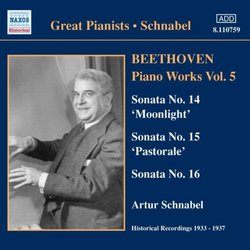The Gold Standard
J Scott Morrison | Middlebury VT, USA | 12/10/2003
(5 out of 5 stars)
"When His Master's Voice (England) made plans to have Schnabel record all of Beethoven's piano sonatas in the 1930s it was a huge financial risk. They ameliorated that risk by signing up subscribers ahead of time.The project became one of the most notable recording efforts up to that time, and it was a success. When finished it came to over 200 78rpm sides and included many of the smaller pieces as well as the full 32 sonatas. The performances became legendary and remain so. Schnabel was and is so revered for his Beethoven playing that no one since has even come close. And for good reason. This issue, number five in the series of CDs that will eventually number eleven, contains Beethoven's most popular sonata, the 'Moonlight,' No. 14 in C sharp minor, Op. 27, No. 2. This is the recording I grew up with. I remember my teacher sitting me down to listen to how Schnabel played the whirlwind third movement and commenting, 'You'll never be able to manage it that well.' That hurt. But, of course she was right. That last movement, in Schnabel's hands is simply titanic. It doesn't matter that there is some sonic distortion in the loudest passages; it's the playing that counts, and we're lucky to still have Schnabel's performance some seventy years later. As for the first two movements of the sonata, one can only marvel at the utter calmness of that famous first movement, and the insouciance of the Allegretto. This performance does not have an equal.The other two sonatas are almost at that level. The 'Pastorale,' No. 15 in D, Op. 28, manages somehow to combine broad tempi with peasant-like joie de vivre. The 'Pastorale' has never been one of my favorite sonatas, but Schnabel makes you believe in it.The Opus 31 sonatas are among my favorites, but No. 1, the sonata included here, tends to be considered the weak sister of the set. Not here. Some music-lovers insist that Beethoven be dramatic, urgent, extreme. In this sonata, rather, we get chuckling, musing, high spirits. The third movement is positively Haydnesque in its humor. Schnabel brings it all off with pearly runs and impulsive dynamic surprises.These transfers from the original 78s are probably the best to be had. Unfortunately there are still a number of distorted passages at high volumes and that can't be helped; it is a combination of the recording techniques of the time and the unavailability of pristine 78s from which to take these transfers. And, particularly in the third movement of the 'Moonlight,' Schnabel makes such huge dynamic contrasts that it was simply impossible at the time to record them without some sonic blasting. I'm convinced that transfer engineer, Mark Obert-Thorn, has made the best case for these recordings; they won't ever be done better. Obviously these should not be one's only recordings of these sonatas. They are historical documents. I wouldn't want to be without modern recordings, but I certainly don't want to be without my Schnabels.Self-recommending.Scott Morrison"

